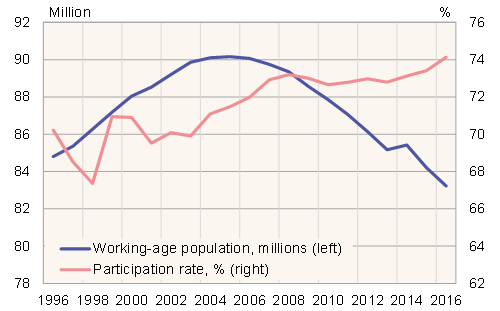BOFIT Weekly Review 31/2017
Number of employed all-time high in Russia
Rosstat reports that the number of people employed in the Russian economy reached around 72.4 million people in June, a slight increase from a year earlier. At the same time, the number of unemployed people decreased slightly. According to preliminary data, the unemployment rate based on ILO methodology was 5.2 % in June. Variations across regions, however, were substantial. The unemployment rate in Moscow was a mere 1.4 % and in St. Petersburg 1.6 % while several republics in the North Caucasus region posted unemployment rates well above 10 %.
Russia has experienced a decline in unemployment that has continued since the start of the millennium; most labour market adjustment has occurred instead through wage flexibility. Much of this dynamic reflects a decline in the size of the working-age population, which peaked in 2005 at 90 million. The working-age population stood at 83 million at the end of 2016. The number of people entering the working-age cohort over the next 15 years will be smaller than the number leaving, so a change in the downward trend is not to be expected anytime soon. Raising retirement ages has been proposed as a way to maintain the size of the labour pool. This, however, would also have a limited impact as a significant share of pensioners already work after they reach retirement age. Over the past 15 years, Russia's labour force participation rate has risen back to levels well above the OECD average.
Russia's working-age population and labour force participation

Sources: Rosstat, OECD and CEIC.